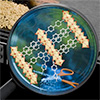| Feb 18, 2025 |
By combining organic and inorganic chemistry, scientists developed the innovative lubricant with remarkable capabilities.
(Nanowerk News) Finding the right lubricant for the right purpose is a task that is often extremely important in industry. Not only to reduce friction, overheating and wear, but also to save energy. At TU Wien, the research groups of Prof Carsten Gachot (Tribology, Mechanical Engineering) and Prof Dominik Eder (Chemistry) are therefore working together to develop innovative, improved lubricants.
|
|
The team has now presented a new type of material with very special properties: The lubricant COK-47 is not liquid like lubricating oil, but a powdery solid substance. On a nanoscale, it consists of stacks of atomically thin sheets, like a tiny stack of cards. When the material comes into contact with water molecules, these platelets can slide past each other very easily – a so-called tribofilm is created, which ensures extremely low friction. This makes COK-47 a highly interesting lubricant in humid conditions.
|
|
The findings have been published in Advanced Science (“Advanced Solid Lubrication with COK-47: Mechanistic Insights on the Role of Water and Performance Evaluation”).
|
Organic and inorganic: the best of both worlds
|
|
The research team has been working with metal-organic frameworks (MOFs) for years. These are a new class of materials that consist of inorganic building blocks connected by organic molecules. There are many possibilities of adapting these materials at an atomic level for a specific purpose – for example, Dominik Eder’s group has used them in recent years as photocatalysts for hydrogen production or for water purification.
|
|
In most cases, metal-organic framework compounds are nanoparticles that contain clusters of metal atoms, linked by organic compounds. “However, the material COK-47 has an important special feature,” explains chemist Pablo Ayala, co-author of the current study. “The inorganic components of this material are two-dimensional sheets of titanium oxide – and this dramatically influences its behaviour.”
|
|
Detailed investigations have now shown that in a humid environment, water molecules separate the bonds between the titanium oxide sheets, allowing the flat structures to slide past each other and thus form a so-called ‘tribofilm’. Such a sliding film can be extremely effective in reducing friction, for example between two moving parts in a machine.
|
Minimal friction, maximum durability
|
|
“We compared COK-47 with other lubricants from the class of metal-organic framework compounds that are often used today. COK-47 showed a significantly lower coefficient of friction than the others,” says engineer Hanglin Li, first author of the study. “COK-47 is also significantly more durable compared to other 2D materials – another important criterion in practice.”
|
|
With this discovery, the team has opened up a whole new area of research in the field of solid-state lubricants. Now they want to further improve the behaviour of the material and investigate how it can be adapted to different, very specific applications.
|

